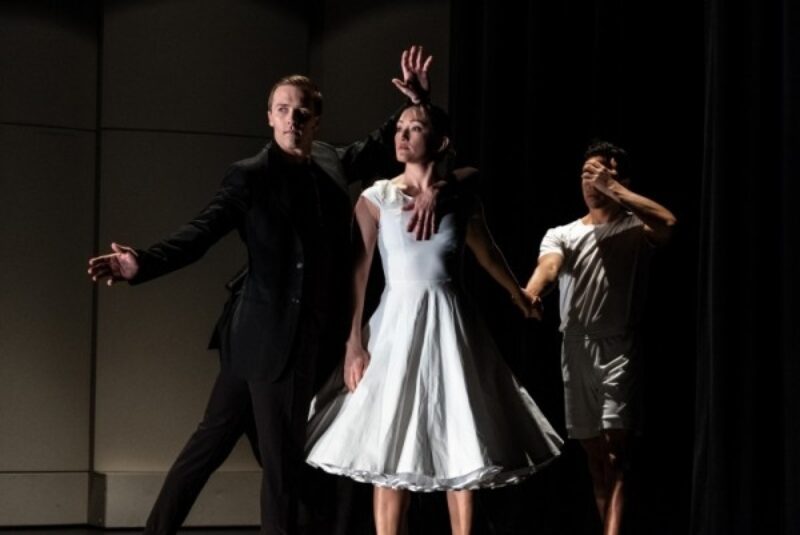When A Mother Outlives Her Son
Review of Pergolesi's Stabat Mater by Early Music Seattle and Whim W'Him.
Written by Teen Editor Hannah Schoettmer, and edited by Teen Editor Anya Shukla!

The Catholic Mass is generally structured around the reading and interpretation of a passage from the Bible. At many of the churches I’ve attended, there’s a service after the Sunday Mass for the kids, where they lead you into a classroom and break down the scripture, as well as teach you the general tenants of Catholicism.
It was in these Sunday school settings that I was first presented with an interpretation of the Virgin Mary. She was said to be a feminine ideal, a figure of compassion and mercy. A Jewish girl selected to be Jesus’ mother due to her openness to God’s will, the Virgin Mary is often held up as a symbol of purity and goodness in humanity, as she was born into an ordinary family and lived an ordinary life up to her “choosing.”
But many biblical figures, like the Virgin Mary, are rather human upon closer look. Pergolesi’s Stabat Mater, a 13th century Christian hymn on the suffering of the Virgin Mary at the crucifixion, focuses on her maternal aspects rather than her divinity. The ancient piece has been interpreted in a musical setting countless times, but Pergolesi’s composition, featuring an orchestral section and two vocal soloists, is one of the most enduring.
At the Early Music Seattle performance I attended, the ancient hymn was accompanied by a modern dance piece performed by Whim W’Him, depicting both the lamentation of Mary and the interplay of other figures from the Catholic trinity.

Whim W'Him dancers in Stabat Mater. Photo by Stefano Altamura.
Classical music is often seen as an untouchable medium, one which places instrumentalists and vocal soloists at center stage and focuses on the presentation of emotion in a musical form. Paired with dance, however, the musicians fell to the background as the dancers from Whim W’Him took the limelight.
The four dancers emerged in pairs, each wearing a distinct costume of either stark white or black, with little ornamentation. Although the characters were loosely defined, it was easy to identify Mary, danced by Mia Monteabaro, largely due to her central role in the dance, as well as her costume: a white dress and beige pumps. The other figure in white, Jim Kent, represented Jesus Christ, playing a key role through his interactions with the other dancers. The two characters in black, loosely representing the presence of God (Karl Watson) and the Holy Spirit (Liane Aung) at the crucifixion, both supported and stole from the dancers representing Christ and Mary through their physical movement, perhaps alluding to the presence of these two figures at the crucifixion. They often oscillated between lifting and guiding—giving aid—and blocking or inhibiting.
The first movement was defined by the genesis of Mary’s grief, shown as she advanced towards an offstage light and threw herself back into throes of lamentation. The dance piece, rather than showing Mary’s grief as a solemn and divine affair, drew out violent emotion through large, sweeping, and sharp movement.
As the piece progressed through the next several movements, Mary’s role shifted from a violent representation of grief to a more motherly figure, which coincided with the introduction of one of the dance’s two key props: a bathtub. The Christ figure was placed in the tub and wheeled around the stage as Mary sprinkled him with white petals, representative of the cleansing element of both the crucifixion and death itself.

Whim W'Him dancers in Stabat Mater. Photo by Stefano Altamura.
The latter six movements were much less narrative and literal, instead seeming to focus on the emotion and nakedness of death, specifically of the crucifixion. These movements utilized a looser approach to the presentation of sheer emotion, and the dancers, while maintaining their roles, became a bit more abstract in their presentation of character.
The musicians, while assuming a more background role, smoothly accompanied the dance. Since the music was live, there was some risk of the dance and music seeming out of sync. However, the chemistry between the dancers and the singers in particular was rather stunning. The soprano and alto soloists often watched the dancers and matched the intensity of their performance with that of the dance.
Perhaps the most captivating element of the performance was the seemingly inherent dissonance between the ancient classical music and the modernness of the choreography. However, I found that the dance, rather than serving as a detriment to the enduring classical score, provided an interesting twist to the presentation of the narrative and of the art, effectively modernizing the ancient setting of the music.
Stabat Mater is, for Catholics, a timeless story of an important figure of divinity. For everyone, the music and dance of the production by Whim W’Him and Early Music Seattle is a captivating exploration of grief and the role of a mother. Either way one approaches it, the performance was a spellbinding capturing of this ancient narrative, and a strong representation of universal feeling between mother and son, between life and death.
The Teen Editorial Staff is made up of 5 teens who curate the review portion of the TeenTix blog and manage the TeenTix Newsroom. More information about the Teen Editorial Staff can be found HERE.
The TeenTix Press Corps promotes critical thinking, communication, and information literacy through criticism and journalism practice for teens. For more information about the Press Corps program see HERE.


